Abstract
The polymerase chain reaction (PCR) was used to detect Treponema pallidum DNA in the cerebrospinal fluid (CSF) of patients with and without syphilis. The CSF from 10 of 19 patients with positive serological tests for syphilis who were being investigated for late syphilis were treponemal DNA-positive. In contrast, the CSF from only one of 30 patients with no known history of syphilis was DNA-positive. CSF from 28 HIV-positive patients was also tested. Fourteen of these patients had central nervous system (CNS) disease and seven were DNA-positive, whereas none of the 14 without CNS disease were DNA-positive. Five of the seven DNA-positive patients had a history of syphilis. Such a history in an HIV-positive patient who had CNS disease was predictive of finding treponemal DNA in the CSF. The PCR had a sensitivity of 47% and a specificity of 93% for detecting a known history of syphilis and is a potentially useful tool in treponemal diagnosis.
Full text
PDF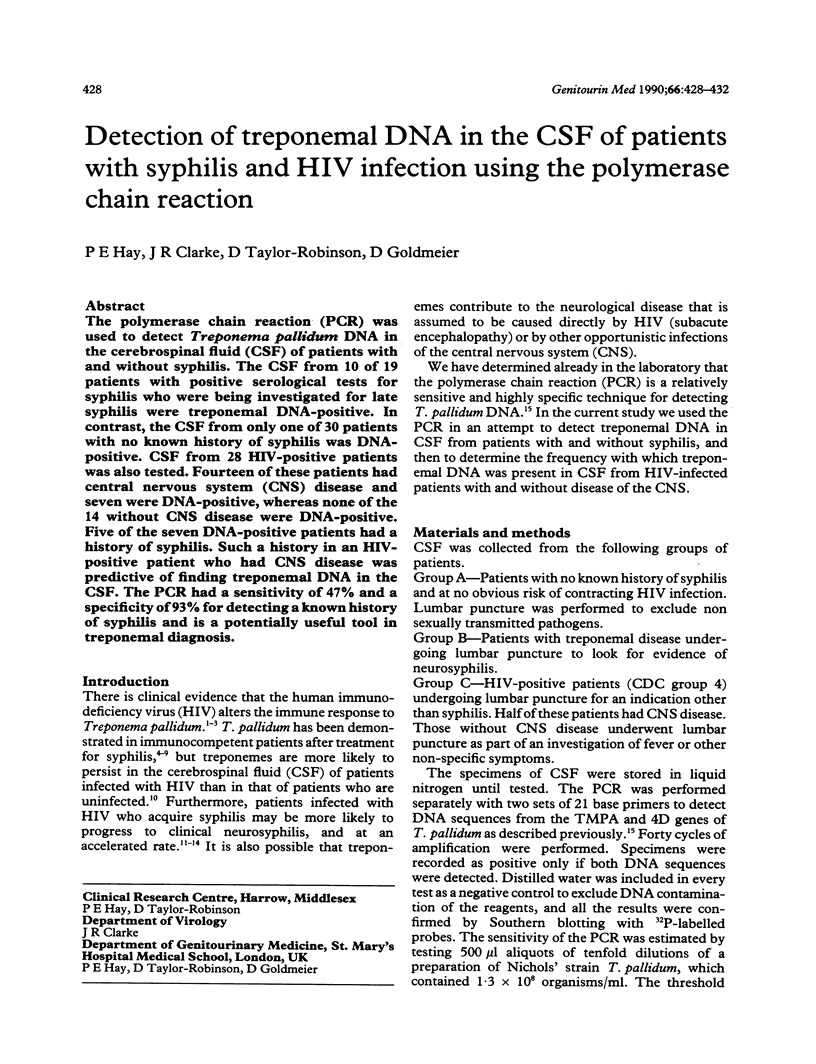
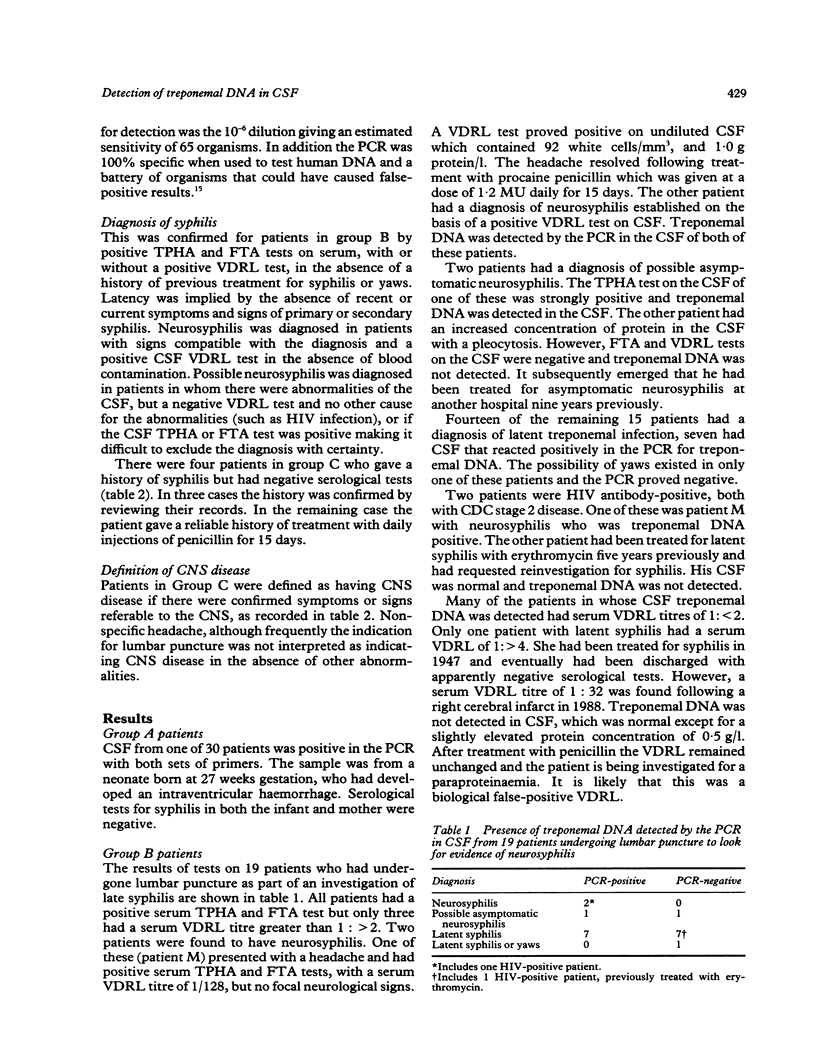
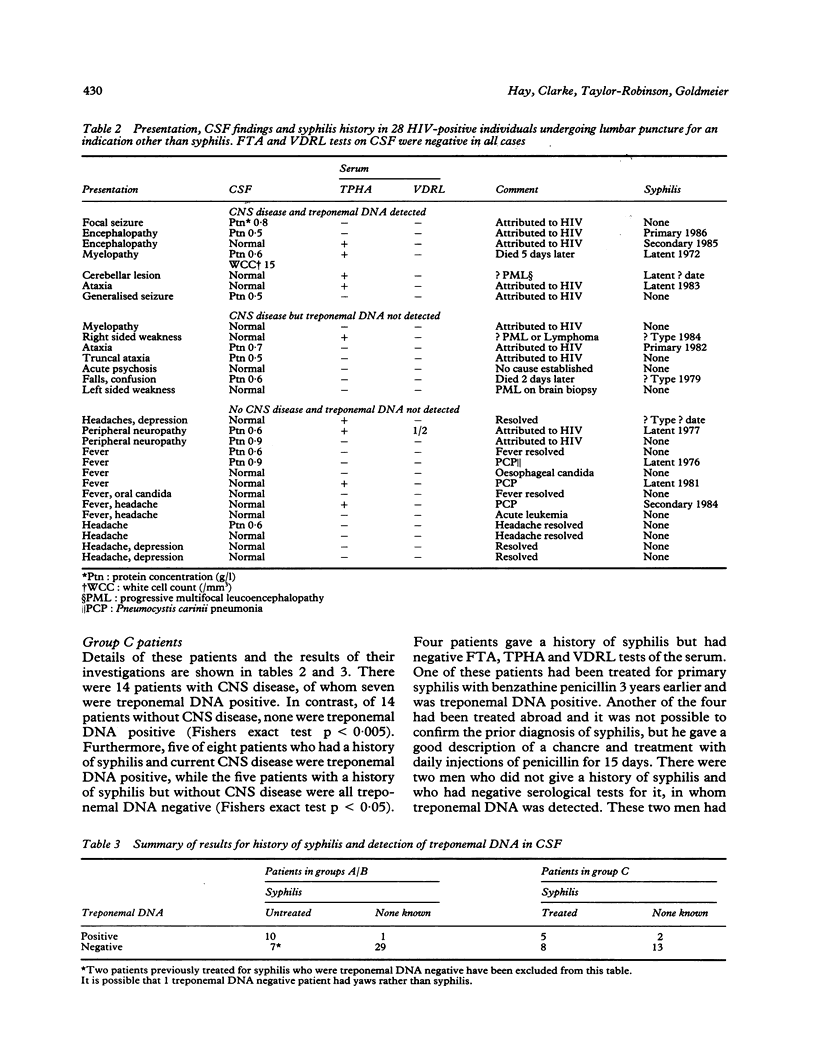
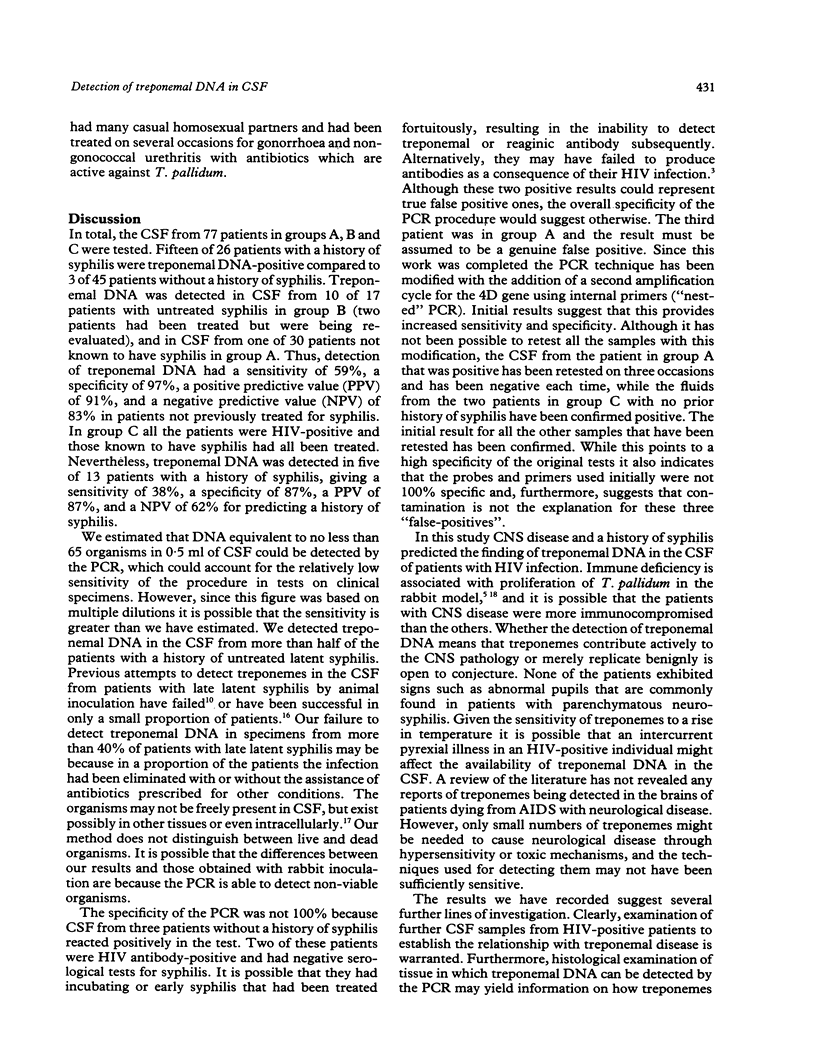
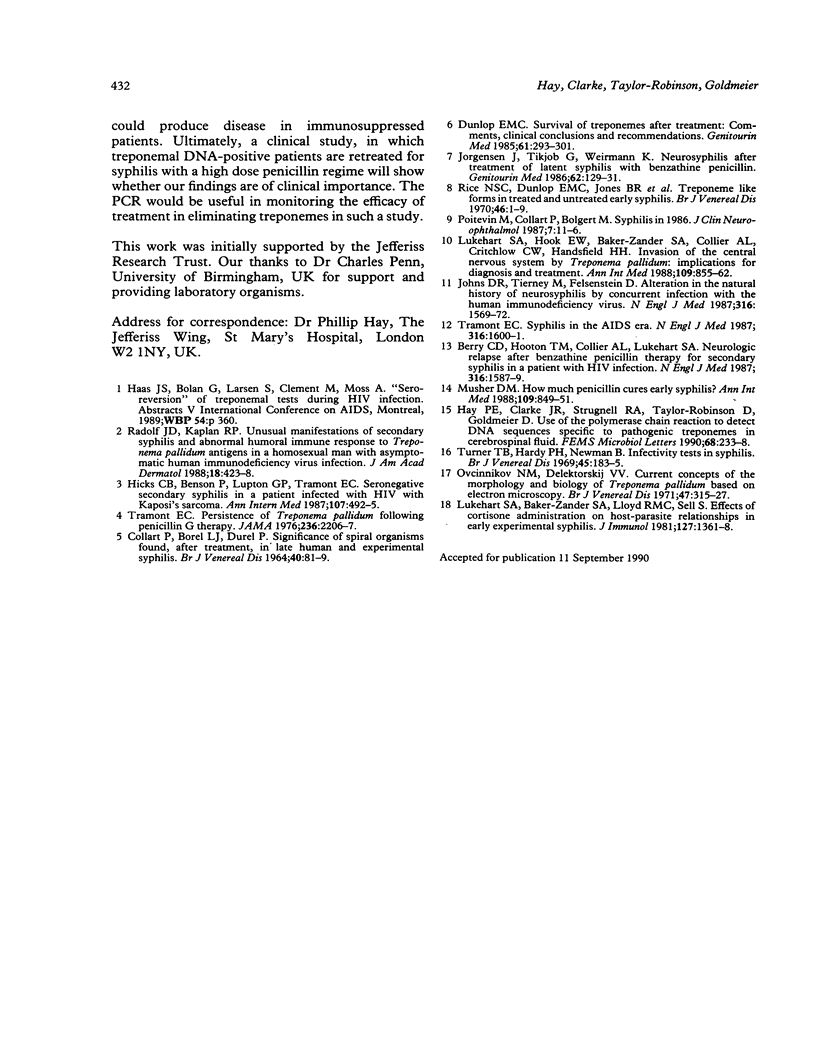
Selected References
These references are in PubMed. This may not be the complete list of references from this article.
- Berry C. D., Hooton T. M., Collier A. C., Lukehart S. A. Neurologic relapse after benzathine penicillin therapy for secondary syphilis in a patient with HIV infection. N Engl J Med. 1987 Jun 18;316(25):1587–1589. doi: 10.1056/NEJM198706183162507. [DOI] [PubMed] [Google Scholar]
- COLLART P., BOREL L. J., DUREL P. SIGNIFICANCE OF SPIRAL ORGANISMS FOUND, AFTER TREATMENT, IN LATE HUMAN AND EXPERIMENTAL SYPHILIS. Br J Vener Dis. 1964 Jun;40:81–89. doi: 10.1136/sti.40.2.81. [DOI] [PMC free article] [PubMed] [Google Scholar]
- Dunlop E. M. Survival of treponemes after treatment: comments, clinical conclusions, and recommendations. Genitourin Med. 1985 Oct;61(5):293–301. doi: 10.1136/sti.61.5.293. [DOI] [PMC free article] [PubMed] [Google Scholar]
- Hay P. E., Clarke J. R., Strugnell R. A., Taylor-Robinson D., Goldmeier D. Use of the polymerase chain reaction to detect DNA sequences specific to pathogenic treponemes in cerebrospinal fluid. FEMS Microbiol Lett. 1990 Mar 15;56(3):233–238. doi: 10.1111/j.1574-6968.1990.tb13943.x. [DOI] [PubMed] [Google Scholar]
- Hicks C. B., Benson P. M., Lupton G. P., Tramont E. C. Seronegative secondary syphilis in a patient infected with the human immunodeficiency virus (HIV) with Kaposi sarcoma. A diagnostic dilemma. Ann Intern Med. 1987 Oct;107(4):492–495. doi: 10.7326/0003-4819-107-4-492. [DOI] [PubMed] [Google Scholar]
- Johns D. R., Tierney M., Felsenstein D. Alteration in the natural history of neurosyphilis by concurrent infection with the human immunodeficiency virus. N Engl J Med. 1987 Jun 18;316(25):1569–1572. doi: 10.1056/NEJM198706183162503. [DOI] [PubMed] [Google Scholar]
- Jørgensen J., Tikjøb G., Weismann K. Neurosyphilis after treatment of latent syphilis with benzathine penicillin. Genitourin Med. 1986 Apr;62(2):129–131. doi: 10.1136/sti.62.2.129. [DOI] [PMC free article] [PubMed] [Google Scholar]
- Lukehart S. A., Baker-Zander S. A., Lloyd R. M., Sell S. Effect of cortisone administration on host-parasite relationships in early experimental syphilis. J Immunol. 1981 Oct;127(4):1361–1368. [PubMed] [Google Scholar]
- Lukehart S. A., Hook E. W., 3rd, Baker-Zander S. A., Collier A. C., Critchlow C. W., Handsfield H. H. Invasion of the central nervous system by Treponema pallidum: implications for diagnosis and treatment. Ann Intern Med. 1988 Dec 1;109(11):855–862. doi: 10.7326/0003-4819-109-11-855. [DOI] [PubMed] [Google Scholar]
- Musher D. M. How much penicillin cures early syphilis? Ann Intern Med. 1988 Dec 1;109(11):849–851. doi: 10.7326/0003-4819-109-11-849. [DOI] [PubMed] [Google Scholar]
- Ovcinnikov N. M., Delektorskij V. V. Current concepts of the morphology and biology of Treponema pallidum based on electron microscopy. Br J Vener Dis. 1971 Oct;47(5):315–328. doi: 10.1136/sti.47.5.315. [DOI] [PMC free article] [PubMed] [Google Scholar]
- Poitevin M., Collart P., Bolgert M. Syphilis in 1986. J Clin Neuroophthalmol. 1987 Mar;7(1):11–19. doi: 10.3109/01658108709007424. [DOI] [PubMed] [Google Scholar]
- Radolf J. D., Kaplan R. P. Unusual manifestations of secondary syphilis and abnormal humoral immune response to Treponema pallidum antigens in a homosexual man with asymptomatic human immunodeficiency virus infection. J Am Acad Dermatol. 1988 Feb;18(2 Pt 2):423–428. doi: 10.1016/s0190-9622(88)70062-6. [DOI] [PubMed] [Google Scholar]
- Rice N. S., Dunlop E. M., Jones B. R., Hare M. J., King A. J., Rodin P., Mushin A., Wilkinson A. E. Demonstration of treponeme-like forms in cases of treated and untreated late syphilis and of treated early syphilis. Br J Vener Dis. 1970 Feb;46(1):1–9. doi: 10.1136/sti.46.1.1. [DOI] [PMC free article] [PubMed] [Google Scholar]
- Tramont E. C. Persistence of Treponema pallidum following penicillin G therapy. Report of two cases. JAMA. 1976 Nov 8;236(19):2206–2207. [PubMed] [Google Scholar]
- Tramont E. C. Syphilis in the AIDS era. N Engl J Med. 1987 Jun 18;316(25):1600–1601. doi: 10.1056/NEJM198706183162510. [DOI] [PubMed] [Google Scholar]
- Turner T. B., Hardy P. H., Newman B. Infectivity tests in syphilis. Br J Vener Dis. 1969 Sep;45(3):183–195. doi: 10.1136/sti.45.3.183. [DOI] [PMC free article] [PubMed] [Google Scholar]


